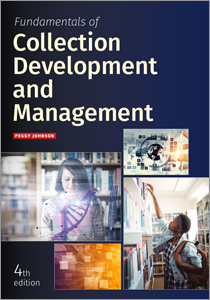Peggy Johnson speaks about her writing process and what's important for today's LIS grads
The first edition of Peggy Johnson's text Fundamentals of Collection Development and Management was published in 2004. Needless to say a whole lot has changed in the last 14 years, and Johnson has kept updating and revising her book to keep current with the field. On the occasion of the publication of the new fourth edition, we spoke with her about her writing process, what's important for today's LIS grads, and what lies ahead.
So, you've just published the fourth edition of your book! Congratulations! What were some of the differences working on the project this time around? And what have you learned over the years that  you wish you'd known from the beginning?
you wish you'd known from the beginning?
The process of research and writing I follow is basically the same as when I worked on the first edition. However, locating resources continues to get easier with full text online indexes and Google Scholar available. I still spend a lot of time verifying details. I confess I continue to print articles and borrow print books through interlibrary loan. I've tried keeping only digital files, but it doesn't work for me. I need tangible copies I can hold and organize. One thing I wish I'd known earlier is how willing librarians and others in the field are to help. With this edition, I reached out to nearly fifty people, all of whom graciously answered my questions and offered advice.
Describe your writing and revision process–is it all electronic, or do you print out some drafts and go to work with a red pencil?
I've always written on the computer, but I do print each chapter about halfway through the writing so I can spread it out on my desk and move parts around. As I write a chapter, I create an detailed outline aiming to have a logical progression. Many of the writing techniques I learned in elementary school remain useful, although I don't take notes on 3X5 cards. Once a chapter is nearly complete, I do the polishing on the electronic file.
Let's say an LIS student approaches you for career advice. After getting that degree, what are some important first steps to take?
I always tell students to get library experience either through in internship or a practicum while in school. Employers look for some familiarity with the real world even when hiring recent LIS graduates. Involvement with professional organizations is important both because of the learning opportunities and because of the contacts made. New librarians seldom realize what a small world the library field is–building a network of support and potential references is critical.
Are vendor relations such as purchasing and licensing materials getting easier or more difficult? Why?
I think vendor relations are more complex. I added a chapter in this edition on vendor relations, negotiation, and contracts in part because library school faculty members and collection development librarians requested it. Once you understand that vendors are trained in selling and promoting their products and especially in negotiating effectively, you realize that librarians need parallel skills. Being aware of all the  variables (and there are many) that go into making the best selection choice for your library is more important than ever. Even librarians who don't make the final choices need to understand the issues and why decisions are made.
variables (and there are many) that go into making the best selection choice for your library is more important than ever. Even librarians who don't make the final choices need to understand the issues and why decisions are made.
What's the most surprising trend in the field of collection development and management? How do you see this discipline evolving over the next 5-10 years?
I first became interested in 1980s in what we were then calling machine readable data files (MRDFs). It seemed obvious that they were going to have a significant and ever-increasing effect on library collections and services, so I can't say I've been surprised by the role digital content plays in today's libraries. Perhaps the wide-spread participation in consortial buying by all types of libraries might be considered surprising, but I'd say it's a logical progression that began with consortial resource sharing. Maybe one development that is, indeed, surprising is the extent to which publishers are selling directly to libraries. Not too long ago, libraries relied on intermediaries (jobbers, vendors, and agents) because publishers didn't want to deal with selling, invoicing, and shipping individual titles. Packages of titles (both e-journals and e-books) have changed the business model and made publishers major players. As far as that goes, I'm guessing that few librarians could foresee the extent to which libraries now purchase large packages of titles. I'm always leery of projecting the future–it is too easy to be wrong. That said, I think that the importance of managing legacy print collections will continue to grow and, I hope, we will see the development and implementation of national preservation and retention plans.
Learn more about the book at the ALA Store.
